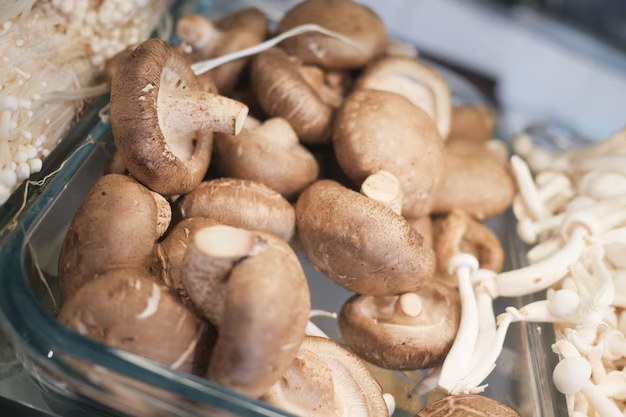A Comprehensive Guide to Storing Mushrooms in Your Refrigerator
Mushrooms are a versatile and delicious addition to many dishes, offering a rich, umami flavor that enhances a variety of meals. However, storing these delicate fungi properly can often pose a challenge. Improper storage can lead to slimy, inedible mushrooms in just a few days. Understanding how to store mushrooms correctly makes all the difference in maintaining their freshness and flavor.
🌱 Understanding Mushroom Varieties
Before diving into storage techniques, it's important to recognize the different types of mushrooms commonly found in kitchens:
- Button Mushrooms: These are the most commonly consumed mushrooms, known for their mild taste.
- Cremini and Portobello: These are simply more mature forms of button mushrooms, offering a deeper flavor.
- Shiitake: Known for their distinctive caps and robust flavor, they are often used in Asian cuisine.
- Oyster Mushrooms: These mushrooms have a tender texture and a subtle, mildly seafood-like taste.
- Maitake: Also called “hen of the woods,” these mushrooms boast a rich, earthy flavor.
Each type has its unique characteristics, which can slightly influence the best storage methods. However, the general approach remains the same.
The Ideal Mushroom Storage Environment
Fresh mushrooms require proper conditions to maintain their texture and flavor. Before you store them, consider these key elements:
- Temperature: Mushrooms prefer a cool environment, ideally in the range of 32°F to 36°F (0°C to 2°C), which makes the refrigerator an excellent option.
- Humidity: They thrive in high humidity environments, around 90%, but it’s crucial to ensure they don't become too damp.
- Airflow: Proper airflow is necessary to prevent moisture build-up, which can lead to spoilage.
🍄 Best Ways to Store Mushrooms
Here’s a step-by-step approach to keeping your mushrooms fresh for as long as possible:
1. Use Paper Towels
Why Paper Towels?
Paper towels absorb excess moisture and help regulate humidity around the mushrooms.
- Steps:
- Begin by placing a layer of paper towels in the bottom of a container.
- Lay the mushrooms over the paper towel in a single layer.
- Cover them with another thin layer of paper towels.
- Tip: Ensure the container can slightly breathe by not sealing it too tightly. A partially open lid or a loosely closed container works well.
2. Opt for a Paper Bag
Why Paper Bags?
Paper bags provide an optimal balance between breathability and moisture retention.
- Steps:
- Gently place your mushrooms into a paper bag.
- Fold the top to loosely close the bag.
- Store the bag in the refrigerator's vegetable crisper for optimal conditions.
3. The Original Packaging
Many supermarket mushrooms come in a container wrapped with plastic. This packaging is typically sufficient for a few days, but for longer storage:
- Steps:
- Remove and check mushrooms for any visible moisture or damage.
- Resituate them with new paper towels as mentioned earlier.
🌟 Pro Tips for Extending Mushroom Shelf Life
- Refrigerate Immediately: As soon as you bring your mushrooms home, store them promptly. This is crucial for preserving their life and taste.
- Avoid Washing Until Use: Washing mushrooms can introduce extra moisture. Instead, only clean them right before use with a damp cloth or a soft brush.
- Spotting Spoilage: Be watchful for mushrooms turning slimy, dark, or emitting a strong odor. This indicates they’re past their prime.
Differing Storage for Dried and Cooked Mushrooms
🌞 Storing Dried Mushrooms
Dried mushrooms are often used for their concentrated flavor and long shelf life. Here’s how to store them:
- Keep in Airtight Containers: Glass jars or vacuum-sealed bags work wonders in preserving their aroma.
- Cool, Dark Place: Store them in a pantry or cupboard away from direct light and heat for maximum lifespan.
🍳 Storing Cooked Mushrooms
Cooked mushrooms, whether grilled, sautéed, or roasted, offer a different storage challenge:
- Use Airtight Containers: These help prevent rule-spreading odors or flavors.
- Refrigerate Promptly: Store cooked mushrooms within two hours of cooking, and they should be consumed within two days for freshness.
Frequently Asked Questions About Mushroom Storage
Can I Freeze Fresh Mushrooms?
Yes, freezing is possible, but with a few procedural steps:
- Sauté or Blanch First: Raw mushrooms can become mushy if frozen without heat treatment.
- Package Well: Use airtight containers or vacuum-seal bags, and consume within a few months for best results.
Does Washing Mushrooms Cause Damage?
- Minimal Water Use: Waterlogged mushrooms are never good. Instead, rely on just enough moisture to wipe away debris with a brush or damp cloth.
Why Not Plastic Bags for Storing?
Plastic confines moisture, accelerating spoilage. Paper or breathable packaging is recommended for mushrooms.
💡 Quick-Glance Tips for Perfect Mushroom Storage
Must-Know Storage Tips for Mushroom Lovers:
- 🕒 Always Use Fresh: Utilize freshly harvested mushrooms when possible.
- 🍂 Mind the Environment: Think cool, humid, and breathable storage environments.
- 🚫 Avoid Overcrowding: Give them space for airflow to keep them fresh longer.
Closing Insight: Mastering Mushroom Storage
Proper mushroom storage might seem intricate, but integrating these practices into your routine ensures that you enjoy mushrooms at their finest. Whether you’re adding them to a warming bowl of soup or sautéing them for a side dish, well-kept mushrooms elevate every culinary creation. By understanding their storage needs, your mushrooms can stay delicious and ready for any mealtime inspiration.
